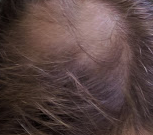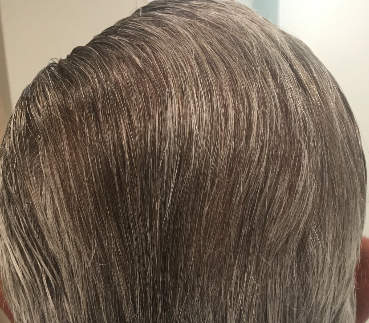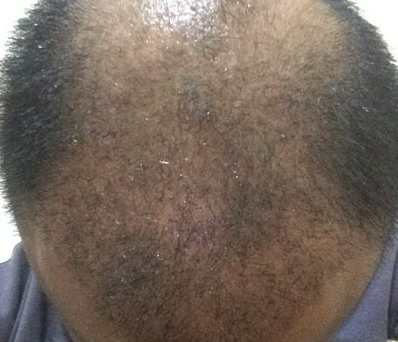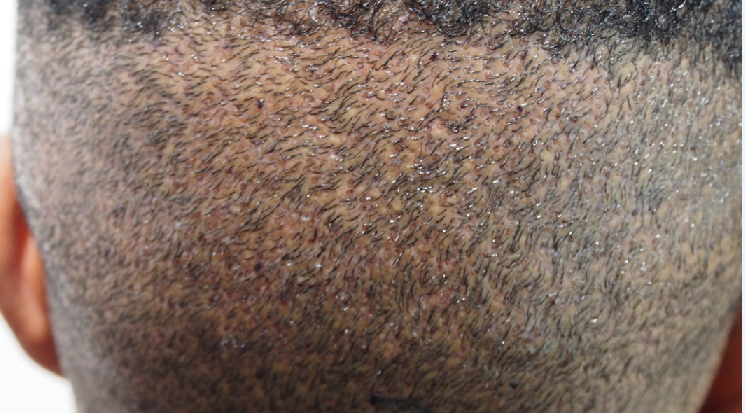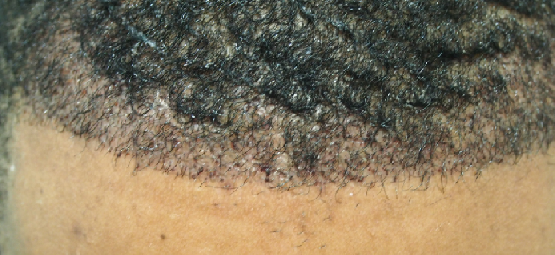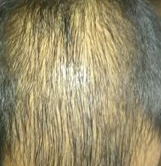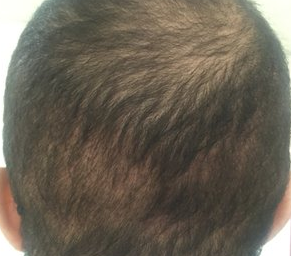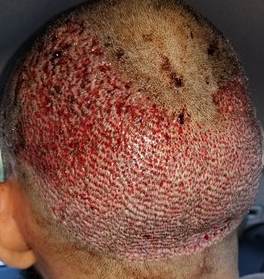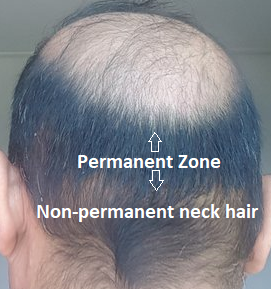It turns out that your picture was my picture 25 years ago as I had the exact balding area in my crown. Then I had hair transplants and now nobody can tell that it ever had a bald spot. The picture on the left is the person asking the question, the picture on the right is a picture of me today with no bald spot present (I like my salt and pepper hair color).
I would rather suggest that you consider a non-surgical cosmetic treatment called Scalp MicroPigmentation which will address the problems shown with less cost and with almost immediate results. A hair transplant takes almost eight months to see results that will not look as good as the example of the two photos on the right (before and after SMP). When hair transplantation is used in the treatment of diffuse hair loss, it almost always leaves a disappointed patient. See some good examples of women who have had Scalp MicroPigmentation can be found on our web-site: https://scalpmicropigmentation.com/smp-for-women/. One example taken from this website is shown below the picture of the thinning haired women who asked the question.
(1) I know it can take up to a year to see results and possible regrowth. In terms of shedding however, will I immediately begin to see less hairfall upon taking the drug? (2) I know side effects are rare, but if I do get any how long should I continue to use finasteride before I should stop? I’ve read that quite often side effects disappear through continued use of the drug. (3) Although finasteride effects beard growth and development, if I stop taking the drug will my beard develop as normal or will it be permanently damaged?
Answers to your questions.
1- I tell my patients to wait a full year to see real benefits but if you do not get a shed when you start the medication, you will see the hair loss slow down or stop in a month or two
2- If the sexual side effects hit you, wait a month or two to see if it goes away, you can cut the dose to one pill every other day which may help
3- Usually, when you stop finasteride, beard hair goes back to normal
The following statistics are very troubling
- Suicide is the SECOND leading cause of death for ages 10-24. (2015 CDC WISQARS)
- Suicide is the SECOND leading cause of death for college-age youth and ages 12-18. (2015 CDC WISQARS)
- More teenagers and young adults die from suicide than from cancer, heart disease, AIDS, birth defects, stroke, pneumonia, influenza, and chronic lung disease, COMBINED.
- Each day in our nation, there are an average of over 5,240 attempts by young people grades 7-12.
- Four out of Five teens who attempt suicide have given clear warning signs
This young man brings the crisis that hair loss has in many young men. Maybe suicide it not the most common option, but when it does happen it is a real tragedy. Depression and many accompanying psychological conditions run parallel to the stress brought on by hair loss. I know that I personally spend a lot of time when I identify such men and I am not always successful because the accompanying infrastructure in my practice just isn’t there. Maybe by posting this, I can bring this to the attention of our readers so that they will be aware when one of their friends or family find themselves in situations like those defined above.
The following was posted on Reddit, a hair loss forum where many young men meet and share their hair loss problems:
Sometimes when a woman has a forehead reduction surgery, or even a face lift, they could develop thinning of the hair on the corners and/or the sides of the hairline. If this is a recent surgery, I would wait a full eight months to see if the hair comes back. Shock loss in women is often reversible on its own. If it does not get better in a year, this area can then be transplanted to make it thick again.
The pictures below were taken three days after an African American had 1,000 FUE grafts in the frontal hairline. Please note the very small FUE wounds are barely detectable as are the grafts. He had no swelling and he had no crusts because we washed them off after the surgery.
This is an example of a young man who had a hair transplant in the first one inch of the frontal area and in the crown of his head. His hairline was perfectly restored and he loved it. During the year following the hair transplant, the hair that he had behind the hairline, which was strong before the transplant, fell out. This is not uncommon in young men as loss of the native hair in a person who has a hair transplant happens as the hair loss process seems to accelerate in men in their 20s following a hair transplant. This man was classified as a Class 3 Vertex pattern of hair loss (frontal loss and crown loss) so we fixed what he wanted fixed. Then, as hair loss is progressive, he lost the rest of the hair behind the hairline as shown in the photo below. He will now have one more hair transplant to fill in this area. This is the photo taken on the day of this second hair transplant to show the extend of the hair loss he had in just a year.
Dutasteride is not approved by the FDA for hair loss. Documentation about such sheds is not available except in the hands of the doctors who prescribe it in what is called an “off label” circumstance. I am sure that it behaves like Finasteride, which suggests that the shed should reverse in 2-3 months. This patient should go back to the doctor who prescribed it and ask him/her what to expect. I hope that this drug was not purchased “over the internet” because the drug may not really be what he expected he was purchasing.
A 4,000 graft FUE surgery, with lower than normal hair density, will produce a depleted donor area as shown in the photo. The see-through look shown may be with him for the rest of his life. FUE is a terrific procedure but when done in excess quantities, balding in the donor area appears. Scalp MicroPigmentation can solve the problem at the cosmetic level.
This photo clearly shows the location of the permanent zone of hair. Many men, when they get older and have Class 7 patterns of balding, will develop balding above and below this permanent zone which usually measures 2 1/2 – 3 inches high. As you can see, the neck hair is being lost and this man will eventually have no neck hair. This is why a surgeon should never use neck hair for a donor source and should not take hair from the fringe areas in the Class 6 pattern patients where the hair may be lost over time as the hair loss moves down the scalp. So this man had too many grafts taken and some of it was taken from areas that are not permanent hair so that he will lose some of the transplanted hair earlier than he would like to see it go.
Britain’s 2008 top talent winner shows off his hair transplant experience. See here: https://www.dailymail.co.uk/tvshowbiz/article-4753368/George-Sampson-shows-results-9k-hair-transplant.html
I started taking 1mg of Finasteride around a month ago, and things started out pretty well. I began to notice a strange burning sensation in my chest. The feeling wasn’t right under my nipple, but it was often around the nipple. This was a very different feeling from what I experience after a day of heavy bench presses at the gym. I stopped taking Finasteride, and the feeling disappeared literally within a day. From your experience, what would you recommend I do?
You may not be a candidate for this drug. Start it up again and if the symptoms return, then you will have nailed the relationship. Of course, speak with your doctor first.
Page 5 of 6


